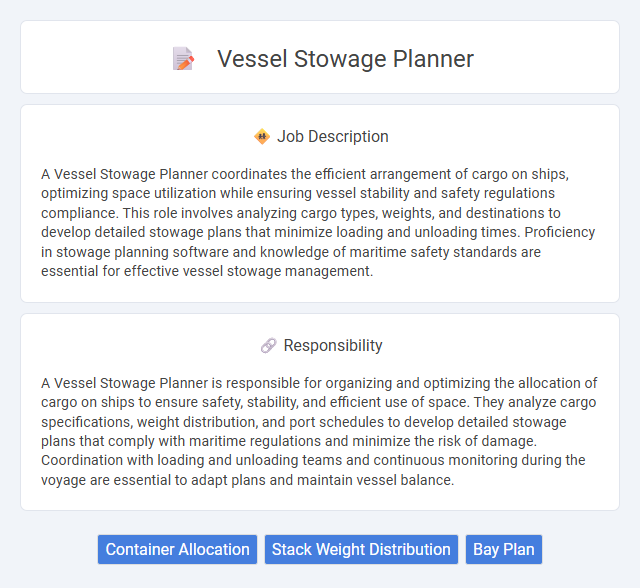
A Vessel Stowage Planner coordinates the efficient arrangement of cargo on ships, optimizing space utilization while ensuring vessel stability and safety regulations compliance. This role involves analyzing cargo types, weights, and destinations to develop detailed stowage plans that minimize loading and unloading times. Proficiency in stowage planning software and knowledge of maritime safety standards are essential for effective vessel stowage management.
Vessel stowage planners are likely to succeed if they possess strong organizational skills and the ability to work under pressure in dynamic environments. Individuals with attention to detail, spatial awareness, and problem-solving abilities may find this role suitable, as it demands precise coordination to optimize cargo space and ensure vessel safety. Those who prefer routine or low-stress tasks might be less suitable given the fast-paced and sometimes high-stakes nature of stowage planning.
Qualification
A Vessel Stowage Planner typically requires a background in maritime studies, logistics, or supply chain management, often supported by a diploma or degree in these fields. Proficiency in stowage software, strong analytical skills, and an understanding of cargo handling and safety regulations are essential. Certifications such as Dangerous Goods Handling (IMDG Code) and experience in vessel operations enhance job eligibility and performance.
Responsibility
A Vessel Stowage Planner is responsible for organizing and optimizing the allocation of cargo on ships to ensure safety, stability, and efficient use of space. They analyze cargo specifications, weight distribution, and port schedules to develop detailed stowage plans that comply with maritime regulations and minimize the risk of damage. Coordination with loading and unloading teams and continuous monitoring during the voyage are essential to adapt plans and maintain vessel balance.
Benefit
A Vessel Stowage Planner job likely offers significant benefits such as enhancing operational efficiency and reducing shipping costs through optimized cargo arrangement. Employees may experience improved workflow management and stronger coordination skills by working closely with ship crews and logistics teams. This role probably increases career prospects in maritime logistics due to its critical impact on safe and timely vessel operations.
Challenge
The vessel stowage planner job likely presents significant challenges in optimizing cargo arrangement to maximize space and maintain vessel stability. Complex constraints such as weight distribution, cargo compatibility, and regulatory compliance increase the probability of encountering difficult problem-solving scenarios. Adapting to last-minute changes and coordinating with multiple teams may further intensify the task's complexity.
Career Advancement
A Vessel Stowage Planner plays a critical role in optimizing cargo placement to maximize ship capacity and ensure safe transport, crucial for efficient maritime logistics. Career advancement opportunities include moving into senior logistics management roles, specializing in supply chain optimization, or transitioning into maritime operations and shipping consultancy. Mastery of stowage planning software, knowledge of international shipping regulations, and strong analytical skills significantly enhance promotion prospects within shipping companies and port authorities.
Key Terms
Container Allocation
A vessel stowage planner specializing in container allocation optimizes cargo placement to maximize ship stability, safety, and efficient unloading sequences. This role requires analyzing container weight, size, and destination to create precise stowage plans that comply with maritime regulations and port requirements. Advanced software tools and real-time data integration enhance decision-making for optimal space utilization and timely cargo handling.
Stack Weight Distribution
Vessel stowage planners specialize in optimizing stack weight distribution to ensure the ship's stability and safety during transit. They analyze cargo weight, container placement, and ship balance using advanced software models to prevent overweight stacks and structural stress. Precise stack weight distribution reduces the risk of cargo shift and improves fuel efficiency by maintaining optimal hull integrity.
Bay Plan
A Vessel Stowage Planner specializes in creating efficient Bay Plans that maximize cargo space utilization while maintaining vessel stability and safety. The Bay Plan details the precise location of containers within each bay, optimizing loading and unloading sequences to minimize port turnaround time and avoid weight distribution issues. Expertise in software like SPARCS or CargoMax and compliance with international maritime regulations are essential for accurate and compliant Bay Plans.
 kuljobs.com
kuljobs.com